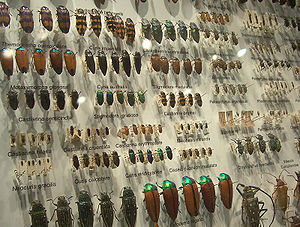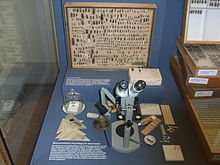- Insect collecting
-
Insect collecting is the collection of insects for hobby, scientific study or profit. Historically insect collecting has been widespread and a very popular educational hobby. Insect collecting has left traces in European cultural history, literature and songs (e.g., Georges Brassens: "La chasse aux papillons" ("The hunt for butterflies"). The practice is still widespread in Japan, especially amongst the youth demographic.[citation needed]
Since most types of insects have hard exoskeletons that retain their appearance after the insects dies, it is easy and practical to form a collection. With many thousands of colorful and attractive species known, a collection may become quite large.
Nowadays some collectors practice their hobby also by rearing caterpillars, or ova, to adulthood. When done well, this procreates more adults than in nature. Some of the adults are released back in the wild, thus minding the numbers of individuals in natural populations. This method has also been used in some conservation programs.
Contents
Specializations
Lepidopterology
Main article: LepidopterologyColeopterology
Main article: ColeopterologyProcess
Locating insects
Insects are common in almost every part of world, and may be easily found by looking closely at plant leaves or flowers, under rocks and boards, in water, and so forth.
Collecting techniques
Aspirators or "pooters"[citation needed] suck up insects too small or delicate to handle with fingers. At night, many types can be caught flying around lights. Funnels, malaise traps, and other types of insect traps, some of which are baited with small bits of sweet foods (such as honey), are also quite effective.
Several different types of nets are commonly used to collect insects. Butterfly nets are used to collect flying insects. The bag of a butterfly net is generally constructed from a lightweight mesh to minimize damage to delicate butterfly wings. A sweep net is used to collect insects from grass and brush. It is similar to a butterfly net, except that the bag is generally constructed from more rugged material such as sailcloth. Other types of nets used for collecting insects include beating nets and aquatic nets.
Once collected, a killing jar is often used to dispatch insects before they damage themselves trying to escape. However, Killing jars are generally only used on hard-bodied insects. Soft-bodied insects, such as those in the larval stage, are generally drowned in a vial containing an ethanol and water solution or formaldehyde, which both kills and then preserves them. Butterflies and moths are not traditionally killed in a killing jar as their wings, which are delicate, can become damaged trying to escape. Instead, the usual method of killing a lepidopteran is by crushing the thorax, and death occurs by suffocation.
Display
The usual method of display is in a glass-covered box, with the insects mounted on specially made non corrosive insect pins stuck into foam board (typically Plastazote) or paper covered cork at the bottom of the box. Common pins are not used. Very small insects are either pinned on "minuten" (very tiny pins) into a block of plastazote borne by a standard insect pin or glued to a small piece of card on the pin. There are specific procedures for proper mounting that are used to show off the insects' unique characteristics. Sometimes variations can be used especially if more than one of a species is available. For example, one or both of the wings of a beetle or grasshopper can be pulled open and fanned out to show the wing structure that would otherwise be hidden. At least the date and place of capture should be written or computer printed on to a piece of paper or card transfixed by the pin. This is called a data label.
Museums frequently have quite large insect collections, used for research. These are not usually on display, since most of them will all look the same to the untrained eye. Rare insects, and/or those from distant parts of the world may also be acquired from dealers or by trading. Some noted insect collections have been sold at auction.
See also
- Bottle trap
- Lepidopterist
References
- Martin, J.E.H. 1977. Collecting, preparing and preserving insects, mites, and spiders. The Insects and Arachnids of Canada, Part 1. Publ. 1643, Res. Br., Canada Dep. Agric., Ottawa, ON.
- Methven, Kathleen R., Michael R. Jeffords and Richard A. Weinzierl. 1995. How to Collect and Preserve Insects. INHS Special Publication 17, Illinois Natural History Survey, Champaign, Illinois. 76 pp.
- Murray S. Upton: "A rich and diverse fauna : the history of the Australian National Insect Collection; 1926–1991". Melbourne : CSIRO, 1997. 386 p. ISBN 0-643-06322-6
- V.M. Uys & R.P. Urban (Eds.): "How to Collect and Preserve Insects and Arachnids". Pretoria 2006. 112 p. ISBN 1-86849-311-3
External links
- Collecting and Preserving Insects and Mites: Tools and Techniques; PDF Comprenhesive, detailed download.
- Expedition Insect Manual PDF
- Chris Raper Insect Collecting Easy to read Excellent illustrations]
- Manchester Museum
- Liverpool Museum
- Coke Smith Insect Collection
- A.Tereshkin Devices for Ichneumonidae collecting.
- Instructions for mounting beetles
Wikimedia Foundation. 2010.



